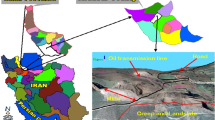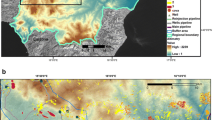Abstract
The paper presents the development of a decision support system for the management of geotechnical and environmental risks in oil pipelines using a geographical information system. The system covers a 48.5 km long section of the São Paulo to Brasília (OSBRA) oil pipeline, which crosses three municipalities in the northeast region of the São Paulo state (Brazil) and represents an area of 205.8 km2. The spatial database was created using geo-processing procedures, surface and intrusive investigations and geotechnical reports. The risk assessment was based mainly on qualitative models (relative numeric weights and multicriteria decision analysis) and considered pluvial erosion, slope movements, soil corrosion and third party activities. The maps were produced at a scale of 1:10,000.
Résumé
L’article présente le développement d’un outil de décision pour la gestion de risques géotechniques et environnementaux concernant des oléoducs sur la base de Systèmes d’Information Géographique (SIG). L’outil de décision concerne une section de 48,5 km de longueur de l’oléoduc allant de Sao Paulo à Brasilia (OSBRA), traversant trois municipalités dans le nord-est de l’état de Sao Paulo (Brésil) et porte sur une surface de 205,8 km2. La base de données spatiales a été créée à partir du traitement de données géologiques, de reconnaissances de surface et en forage et de rapports géotechniques. L’évaluation du risque a été basée principalement sur des modèles qualitatifs (analyse multicritère avec pondération numérique des paramètres) et en considérant l’érosion pluviale, les mouvements de terrain, l’altération des sols et les activités anthropiques. Les cartes ont été produites à l’échelle du 1/10,000.









Similar content being viewed by others
References
Augusto Filho O, Cerri LES, Savage WZ (2002) Landslide quantitative risk mapping using GIS technologies and implementation of insurance plans in Brazilian urban areas. In: Proceedings of the 9th congress of the international association for engineering geology and enviroment, Durban. CD-ROM, pp 464–474
Companhia de Tecnologia de Saneamento Ambiental—CETESB (2008) <http://www.cetesb.sp.gov.br> (Accessed in 10/10/2008)
Einstein HH (1997) Landslide risk—systematic approaches to assessment and management. In: Proceedings of the international workshop on landslide risk assessment, A.A. Balkema, pp 25–49
Einstein HH, Karan KS (2001) Risk assessment and uncertainties. In: Proceedings of the international conference on landslides—causes, impacts and countermeasures, Davos, VGE, pp 457–488
Ensslin L, Montibeller Neto G, Noronha SM (2001) Apoio à decisão: metodologias para estruturação de problemas e avaliação multicritério de alternativas. Florianópolis, p 295
Environemental System Research Institute—ESRI (2007) Arcgis help desktop
Hugrel C (1998) Contribution à l’élaboraion d’um outil d’aide à la décision mlticritére pour la mise em place de la politique environnementale des collectivitès locales (Institut des Sciences Appliquees de Lyion, France), p 200
Hutchinson MF (1993) Development of a continent-wide DEM with applications to terrain and climate analysis. In: Goodchild MF et al (eds) Environmental modeling with GIS. Oxford University Press, New York, pp 392–399
Iglarova L, Klukanova A, Paudits P (2002) Monitoring information system of geological factors in an environment in Slovakia. In: 9th congress of the international association for engineering geology and enviroment, Durban. CD-ROM, pp 2784–2789
Kirsanov AA (2000) Application of integrated GIS at natural resources study. In: Proceedings of the 31th international geological congress. Rio de Janeiro, CD-ROM, p 9
Maystre LY, Pictet J, Smos J (1994) Méthodes multicritères electre. Ed. Lausanne, Presses Polytechniques et Universitaires Romandes, p 37
Rosenbaum MS (2002) Decision support tools within GIS assist environmental modelling. In: Proceedings of the 9th congress of the international association for engineering geology and enviroment, Durban. CD-ROM, pp 2830–2837
Voznessenskaya VV, Voznesensky EA, Samarin EN (2000) Multifaceted evaluation of the ecological risk of maintenance of oil and gas fields. In: Proceedings of the 31th international geological congress. Rio de Janeiro, CD-ROM, p 9
Working Group Committee on Risk Assessment (1997) Quantitative risk assessment for slopes and landslides—the state of the art. In: Proceedings of the international workshop on landslide risk assessment, A.A. Balkema, pp 3–14
Acknowledgments
This work had financial support from the Fundação de Amparo a Pesquisa do Estado de São Paulo—Fapesp, Brazil (Project 05/00044-1).
Author information
Authors and Affiliations
Corresponding author
Rights and permissions
About this article
Cite this article
Augusto Filho, O., Hirai, J.N., Oliveira, A.S. et al. GIS applied to geotechnical and environmental risk management in a Brazilian oil pipeline. Bull Eng Geol Environ 69, 631–641 (2010). https://doi.org/10.1007/s10064-010-0310-2
Received:
Accepted:
Published:
Issue Date:
DOI: https://doi.org/10.1007/s10064-010-0310-2




